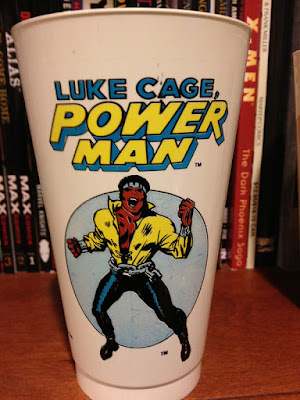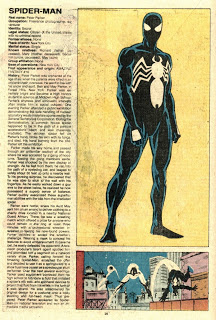1970s pop culture with humor and brains: Marvel's Essential Defenders vol. 3 by Gerber, Kraft, Buscema, Giffen and the gang
Marvel Comics Group- in its phase as a slightly anarchic bastion of experimentation and creativity- published the comics reprinted here from 1976 to 1978,
Leading off this volume we have the second half of Steve Gerber's run.
 The Steve Gerber stories are SO creative and smartly-written, with Buscema's competent layouts and nice superhero art.
The Steve Gerber stories are SO creative and smartly-written, with Buscema's competent layouts and nice superhero art. I can't miss talking about Luke Cage's appearances here- still a street-level hero-for-hire, but a distinct voice with a set of experiences that reverberate nicely beside white privileged Nighthawk and the brainy Soviet heroine, Red Guardian. (Dr. Tania Belinsky, aka The Red Guardian, comes into the story through her civilian identity as a surgeon, to conclude the most bizarre hostage situation of the Marvel Age- involving Nighthawk's brain!) The awkwardness of down-to-Earth Luke (and to some extent, Jack Norriss) alongside the bizarre nature of their capers really accents the stories. A parody of 70's self-help fads turns out to be a terrific, if byzantine, villainous plot. Luke's language is less weighted down by "jive" Blaxploitation slang and reflective of a street-smart, self-taught intelligence, beside the wise, bookish and fatherly Stephen Strange.
I can't miss talking about Luke Cage's appearances here- still a street-level hero-for-hire, but a distinct voice with a set of experiences that reverberate nicely beside white privileged Nighthawk and the brainy Soviet heroine, Red Guardian. (Dr. Tania Belinsky, aka The Red Guardian, comes into the story through her civilian identity as a surgeon, to conclude the most bizarre hostage situation of the Marvel Age- involving Nighthawk's brain!) The awkwardness of down-to-Earth Luke (and to some extent, Jack Norriss) alongside the bizarre nature of their capers really accents the stories. A parody of 70's self-help fads turns out to be a terrific, if byzantine, villainous plot. Luke's language is less weighted down by "jive" Blaxploitation slang and reflective of a street-smart, self-taught intelligence, beside the wise, bookish and fatherly Stephen Strange.

Deep-dyed comic fans often recall "Who Remembers Scorpio?" as a highlight of 70's Marvel.Scorpio himself, dark while still comic-book-colorful, has more of a real personality in his arc here than maybe any single antagonist before him in Marvel history. In his self-awareness and personal disgust with the inhumanity of society and its commercial systems, he's a clear precursor to acclaimed modern writing, with motivations and expressions that are both misguided yet realistic and understandable. Dave Kraft writes inventively, no less so here, where even the confrontation in the mighty Marvel manner comes about unconventionally. He nails the Defenders' classic non-team description so well there, as you'll see. Scorpio must've been puzzling and haunting to many young fans, but his existence inspires a sort of introspection that fits squarely with the "college campus crowd" that lent Marvel its early cache of pop coolness. It's unsettling how this young writer poses a comic book super villain- a goofy cliche in the minds of dismissive adults- with authentic depression struggles that seem drawn from some real fifty-two year old. You can be forgiven rooting for his bizarre plan to make his mark work- despite its villainous incarnation, he seeks a society of his own, as he feels profoundly disconnected from socializing. Their issue-long awakening in #50 is brief, but a hint of some offbeat characterization- especially in Gemini, divided in loyalty over the conflict- shimmers through in the most interesting take on the Zodiac I ever read.
 Perhaps it's just as well the mystique behind his origins remain unrevealed. DAK is still busy drawing realistic characters from real life in his co-writing and editing effort, Yi Soon Shin, a trilogy of comics with Chicago's Onrie Kompan. The draw to the real world in the midst of fantastic entertainment reflects in Kraft's decade-plus long career editing and publishing Comics Interview- now available in hard back volumes.
Perhaps it's just as well the mystique behind his origins remain unrevealed. DAK is still busy drawing realistic characters from real life in his co-writing and editing effort, Yi Soon Shin, a trilogy of comics with Chicago's Onrie Kompan. The draw to the real world in the midst of fantastic entertainment reflects in Kraft's decade-plus long career editing and publishing Comics Interview- now available in hard back volumes.

Kraft gets the advantage of Keith Giffen on art for a while- the results are uneven, but dynamic! Kraft picks up the intelligent and unconventional, creative vibe from Gerber, having proof-read his books and become friends with Steve, himself. "The Dude" particularly writes great female characters. His Hellcat is actually a successful feminist role model without falling into didactic, manifesto-laden agendas- instead, she (and her teammates) has an actual personality! A sex drive (hinted with a confident wink)! A sense of humor- and empathy! Kraft even turns in a subtle Nighthawk story-and a parallel to the Scorpio-driven critique of modern commerciality- that sets him up with a unique perspective in a way that jibes with Gerber's efforts to distinguish Kyle Richmond from his Batman-clone origins. He sends Valkyrie to college- a storyline that reflects the way classic Marvel would mix the world outside your window with the fantastic. It's cool because both his female leads are not cookie cutter women- they've both moved on from early relationships in an attempt to define themselves. Val's campus forays spark an attempt at collecting some supporting characters besides Jack Norriss for Dynamic Defenders.
Both Kraft and Gerber use the Hulk to great effect- the hook for little kids to enjoy the book. Hulk also provides comic relief under both authors in his unbridled-id way. His limitations work well within an ensemble. He still maintains the "self-awareness" tone, even in his brilliantly simple dialogue.
 Kraft seemed to have an affinity for the workings of Marvel's green people-his She Hulk run is different and rather daring for its time, setting another standard, not only for her personality, but as a bench mark for a new kind of heroine.
The return to Russia- following an old school misunderstanding battle between Hulk and Namor, with Kirbyesque panache and callbacks to Jack's Fantastic Four work- is also a brilliant way of displaying the changing attitudes from the days of bland evil Commie enemies.
Kraft seemed to have an affinity for the workings of Marvel's green people-his She Hulk run is different and rather daring for its time, setting another standard, not only for her personality, but as a bench mark for a new kind of heroine.
The return to Russia- following an old school misunderstanding battle between Hulk and Namor, with Kirbyesque panache and callbacks to Jack's Fantastic Four work- is also a brilliant way of displaying the changing attitudes from the days of bland evil Commie enemies. If The Presence isn't a Mao-inspired poet-super-villain, what is he?There's also an environmental theme about radiation contamination and the oceans, tied by Atlantis to world politics- ambitious, yet still a straight-ahead superhero adventure. The collaborations with Carmine Infantino go from rather ultra-smooth and slick (this may have been Janson's finishes) to an awful, distorted look the next issue. That's too bad, because this is the introduction of Lunatik, a pop-culture-quoting scofflaw with insane and violent vendettas of his own against rule-breakers.
 This Alice Cooper- inspired menace deserved return engagements; other writers could've constantly updated Lunatik's lyrics-driven lingo to cool effect. No shit, he and Dr. Strange were David (Kung Fu) Carradine's two favorite Marvel characters.
The return of Dr. Strange in the last stories is pretty awesome; the rock and roll vibe of the book reaches its climax here, and also brings us Devil-Slayer- another obscure Marvel character with quirky unmet potential. Ed Hannigan turns in pretty solid work, too.
My 2010 posts dive into the wealth of Steve's work; I have a couple of new ones referencing DAK's run.
This volume's very cool for giving you a glimpse at some under-appreciated efforts to transition from the Marvel of Stan Lee to the modern interpretation. It's better than nostalgia- it's written to entertain all ages, in a way that bears a standard for the sort of comics the late Darwyn Cooke championed famously.
Keep in mind, these can also be had at a modest price, as the original singles in color- the black and white reprints here are a decent way to get the stories and see what you like best!
This Alice Cooper- inspired menace deserved return engagements; other writers could've constantly updated Lunatik's lyrics-driven lingo to cool effect. No shit, he and Dr. Strange were David (Kung Fu) Carradine's two favorite Marvel characters.
The return of Dr. Strange in the last stories is pretty awesome; the rock and roll vibe of the book reaches its climax here, and also brings us Devil-Slayer- another obscure Marvel character with quirky unmet potential. Ed Hannigan turns in pretty solid work, too.
My 2010 posts dive into the wealth of Steve's work; I have a couple of new ones referencing DAK's run.
This volume's very cool for giving you a glimpse at some under-appreciated efforts to transition from the Marvel of Stan Lee to the modern interpretation. It's better than nostalgia- it's written to entertain all ages, in a way that bears a standard for the sort of comics the late Darwyn Cooke championed famously.
Keep in mind, these can also be had at a modest price, as the original singles in color- the black and white reprints here are a decent way to get the stories and see what you like best!



Comments
Post a Comment